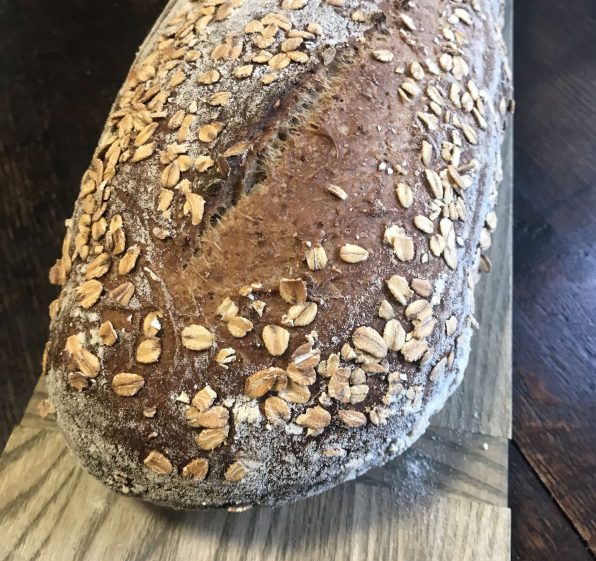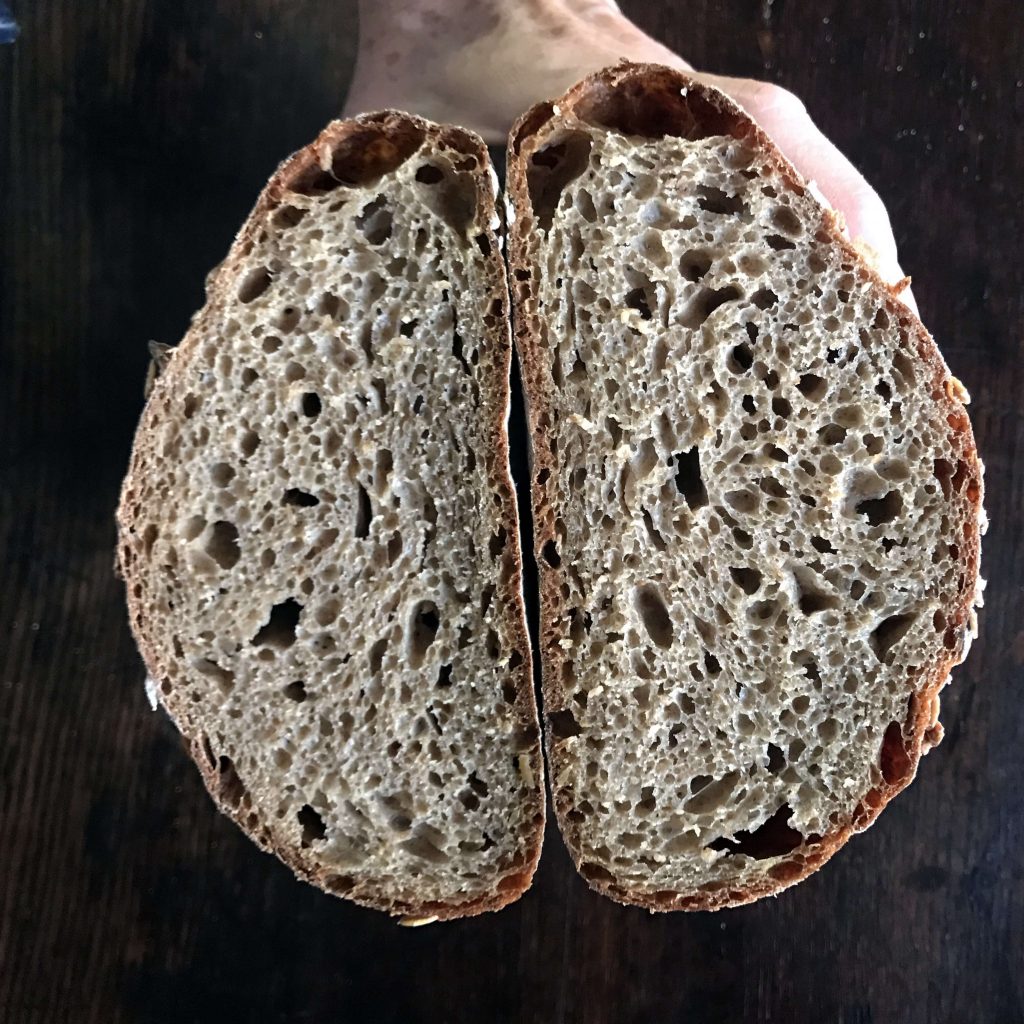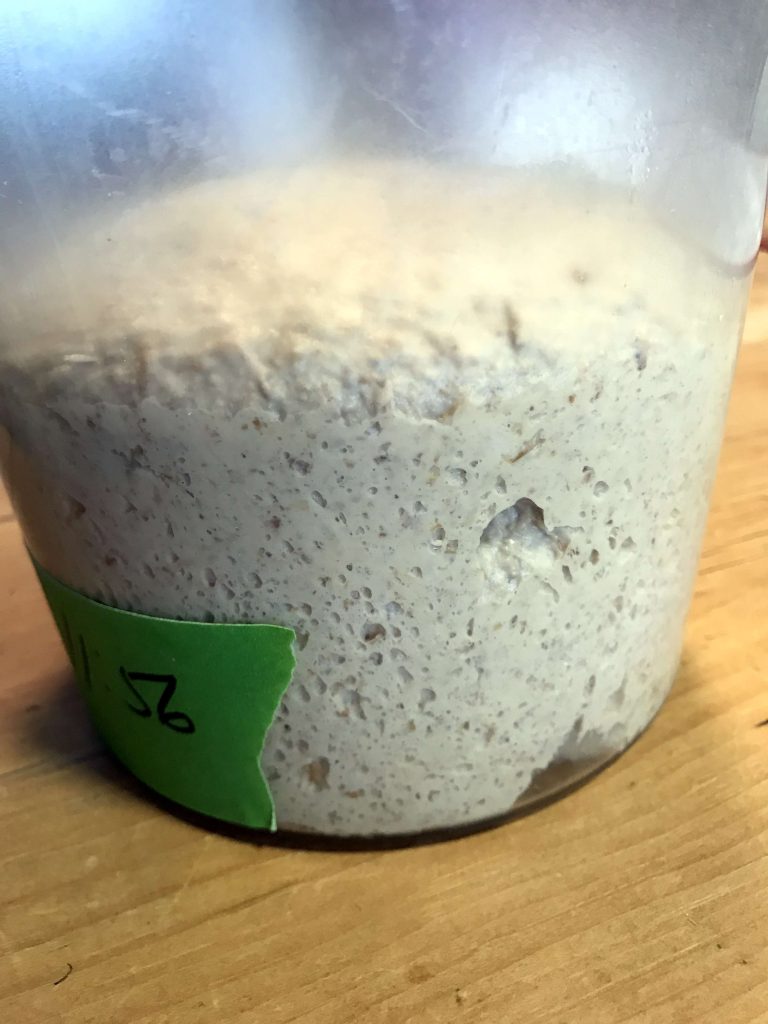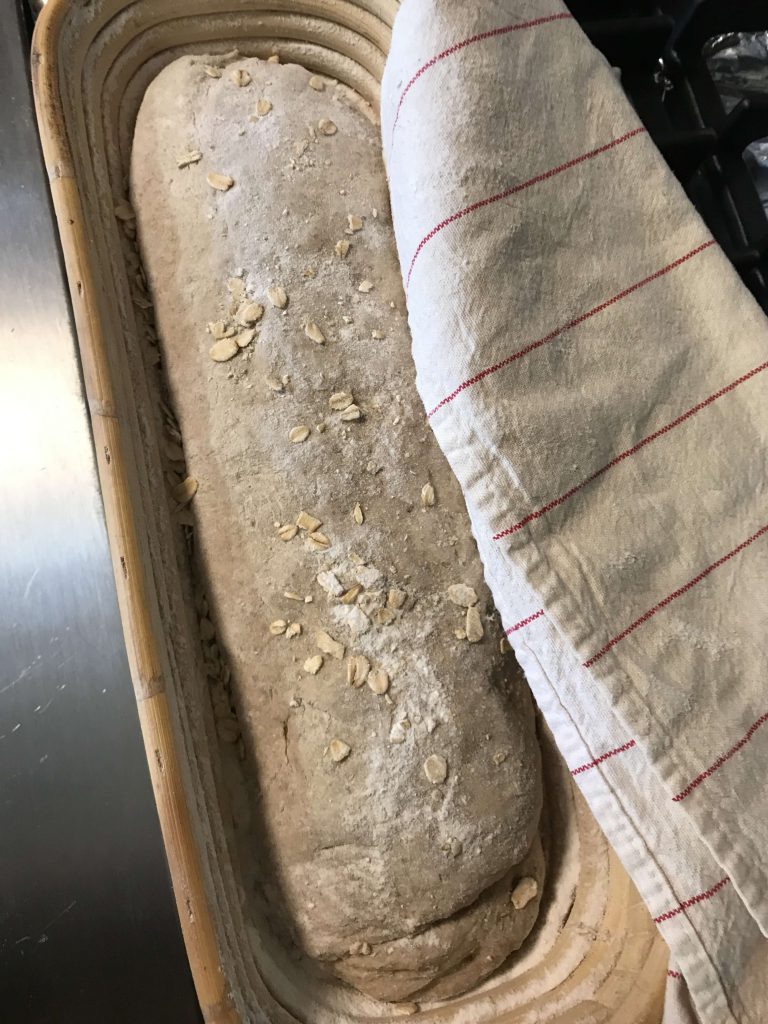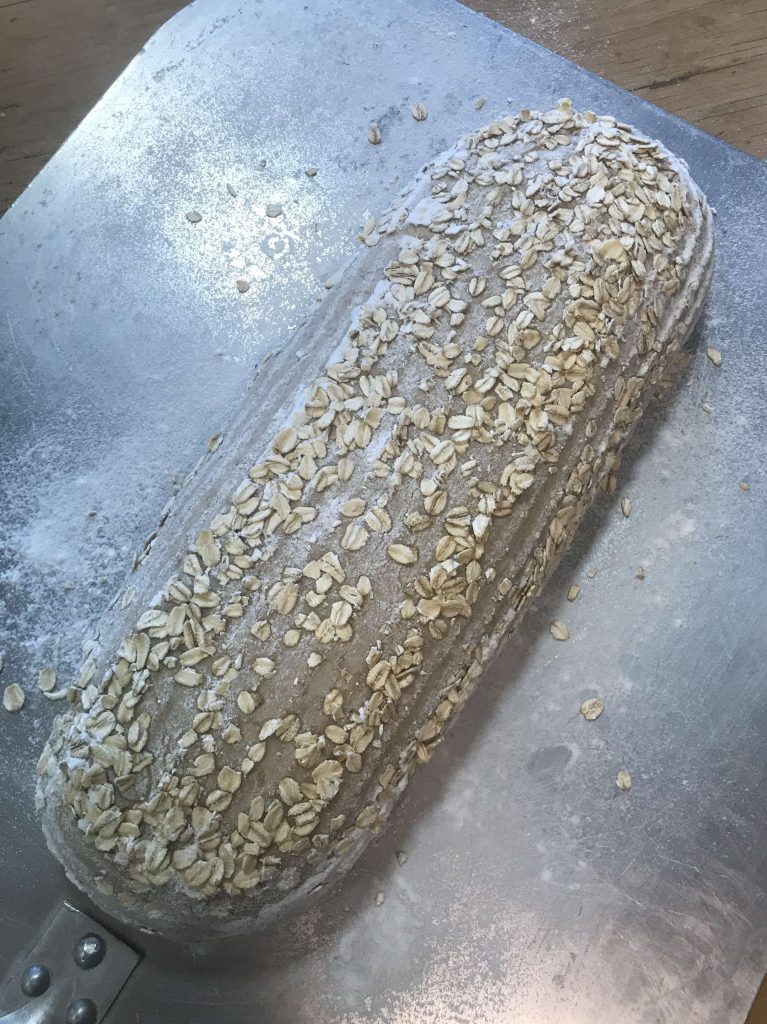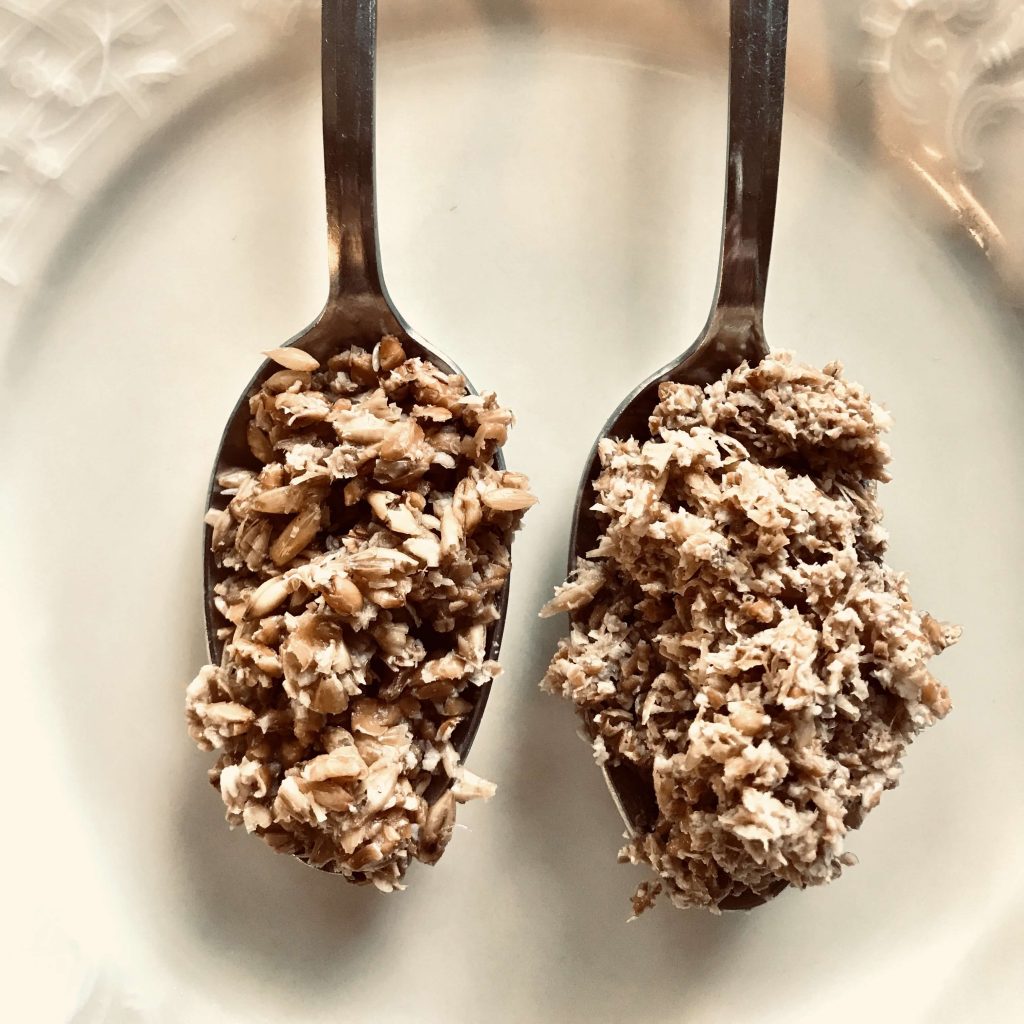The name of this bread doesn’t refer to its size or shape, but rather to the heavy, strongly flavored brew that flavors this dark loaf. This robust Stout Bread complements cheddar cheese, smoked fish and meats, stews and hearty vegetables. It’s perfect for wintertime baking.
With a large percentage of wheat flour, the bread has a springy interior crumb. The flavor of the dough improves with a long fermentation and oatmeal or cracked rye on the surface of this loaf gives it an earthy look. Substitute wheat bran, or a dusting of whole wheat flour if you prefer. When you make this bread, try a rich dark brew from a local producer, or use Guinness Stout.
Here is the tender dough after fermentation (rising) and doubling in bulk.
I formed the dough into a nice oblong shape and let it proof in a willow banneton. First, I dusted the banneton with flour then with coarse oatmeal flakes. You could also bake it in a round shape or in a greased loaf pan too.
When I unmolded the proofed loaf onto a baking peel, the oatmeal left an even coating on the surface of the dough.
Spent Grains
You might be fortunate to score some spent grain from your local brewer as I did. (Carlisle Schaeffer of The Little House Brewing Company in Chester, Connecticut where we live gave me some.) Spent grain is what’s left when beer is drained of the wheat, hops and other ingredients used to make it. Spent grains add flavor and fiber, a great addition to hearty breads. They are great in the bread but totally optional.
A little goes a long way though. The grains have their coarse exterior shells intact. You may need to run them through a food processor to make the tough grains more digestible. The unprocessed spent grains are on the left and the grains after processing are on the right.
Also, you’ll want to drain the grains thoroughly because any excess moisture clinging to them will be added to your dough.
The ingredients in this recipe are listed in US measures, grams and volume. Use one measurement system or the other. The relationship between the ingredients is calculated based on Baker’s Percentage. Measurements from ounces to grams are not direct equivalents.
Ingredients
4 ounces (150 grams/½ cup) active sourdough starter
14 ounces (425 grams/3¼ cups) unbleached bread flour
2 ounces (75 grams/¼ cup) coarse rye flour
1 scant teaspoon (15 grams) fine sea salt
1 teaspoon instant yeast
8 ounces (250 grams/1½ cups) Guinness Stout, or other dark beer, at room temperature
4 ounces (150 grams/½ cup) cracked rye grain or spent grain from a brewery if available, optional
Rolled oats, as needed
Rice flour, as needed
Directions
- Two to four hours before you plan to mix the dough, feed your starter. Allow the starter to sit at room temperature until it is bubbly and visibly active.
- Place the flours, salt, and yeast in a food processor fitted with the metal blade. Measure out the 4 ounces (150 grams/1/2 cup) of the active starter and pour it into the processor. (Cover the remaining active starter with plastic wrap and place it in the refrigerator for future use.)
- Using an instant-read thermometer, adjust the temperature of the beer so that the combined temperatures of the flour and the beer is a base temperature of 140°F. (To warm the beer if necessary, place it in a metal bowl set over hot water. Stir for a few seconds and measure the temperature with an instant read thermometer. Or cool the beer by placing it in a metal bowl set over chilled or ice water. Stir for a few seconds then measure the temperature with an instant-read thermometer. Repeat until desired temperature is reached.)
- With the machine running, pour all but 2 tablespoons of the beer through the feed tube. Process for 20 seconds, adding the remaining beer if the dough seems too dry and does not come together into a ball during this time. Continue mixing the dough another 25 seconds so that it mixes for a total of 45 seconds.
- Stop the machine and take the temperature of the dough with an instant-read thermometer. It should be between 75°F and 80°F.
- Scrape the dough from the processor onto a lightly floured work surface. The dough will feel soft and springy. If using spent grains, flatten the dough and sprinkle it with the spent grains. Fold the dough over and knead the grains gently into it.
- Scrape the dough into a ball. Place it in a large ungreased bowl. Cover the bowl tightly. Allow the dough to ferment for about 2 ½–3 hours at room temperature. The dough will have increased in volume and appear billowy.
- Turn the dough onto a lightly floured work surface. Handle gently and form the dough into a long oval shape. Cover the dough and let rest while you prepare a proofing basket.
- Sprinkle a willow proofing basket, a banneton or a cloth-lined basket with flour. Sprinkle the oatmeal flakes into the bottom of the basket. Place the dough into the basket, seam side up. Cover with a kitchen towel and let the dough proof for 1–2 hours until it has visibly risen.
- One hour before baking, put the oven rack on the second shelf from the bottom of the oven and place the baking stone on the rack. Place a small pan on the floor of the oven. Preheat the oven it to 475°F.
- Invert the loaf onto a peel or the back of a baking sheet that has been sprinkled with rice flour. Score the length of the dough with a deep slash.
- Immediately slide the loaf onto the baking stone. Carefully toss about ½ cup hot water into the pan in the oven. Bake for 20 minutes. Reduce the heat to 400°F and bake until the loaf is well browned and cooked though, for approximately 25 more minutes. Using an instant-read thermometer, the loaf will be finished when it reaches an internal temperature of 205°F–210°F.
- Remove the bread from the oven and immediately place it on a wire rack to cool. This bread will stay fresh for three days at room temperature when covered with a kitchen towel.
Notes
Long fermentation tips. Reduce the yeast to ¼ –½ teaspoon. Retard the formed dough in Step 9 for 4 – 6 hours in the refrigerator. Remove the formed loaf from the refrigerator and let it warm to 60°F –62°F, which may take 1 to 2 hours before baking.

